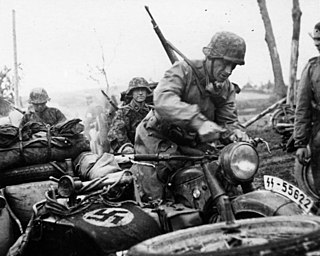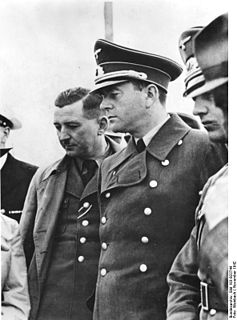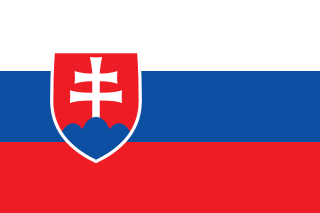
The Waffen-SS was the armed wing of the Nazi Party's SS organisation. Its formations included men from Nazi Germany, along with volunteers and conscripts from both occupied and un-occupied lands.

Organisation Todt (OT) was a civil and military engineering organisation in Nazi Germany from 1933 to 1945, named for its founder, Fritz Todt, an engineer and senior Nazi. The organization was responsible for a huge range of engineering projects both in Nazi Germany and in occupied territories from France to the Soviet Union during World War II. It became notorious for using forced labour. From 1943-45 during the late phase of the Third Reich, OT administered all constructions of concentration camps to supply forced labor to industry.

Fritz Todt was a German construction engineer, senior Nazi, who rose from "Inspector General for German Roadways" where he directed the construction of German Autobahnen (Reichsautobahnen) to Reich Minister for Armaments and Ammunition where he directed the entire war military economy. At the beginning of World War II he initiated what Hitler named Organisation Todt, a military engineering company which supplied industry with forced labor and administered all constructions of concentration camps in the late phase of the Third Reich. He died in a mysterious airplane crash in 1942.

Odilo Globočnik was an Austrian war criminal. He was a Nazi and later an SS leader. As an associate of Adolf Eichmann, he had a leading role in Operation Reinhard, which saw the murder of over one million mostly Polish Jews during the Holocaust in Nazi extermination camps Majdanek, Treblinka, Sobibór and Bełżec. Historian Michael Allen described him as "the vilest individual in the vilest organization ever known".

Hermann Julius Höflepron. also Hans (or) Hermann Hoefle was an Austrian-born SS commander and Holocaust perpetrator during the Nazi era. He was deputy to Odilo Globocnik in the Aktion Reinhard program, serving as his main deportation and extermination expert. Arrested in 1961 in connection with these crimes, Höfle committed suicide in prison before he could be tried.

The Ordnungspolizei, abbreviated Orpo, were the uniformed police force in Nazi Germany between 1936 and 1945. The Orpo organization was absorbed into the Nazi monopoly on power after regional police jurisdiction was removed in favor of the central Nazi government. The Orpo was under the administration of the Interior Ministry, but led by members of the Schutzstaffel (SS) until the end of World War II. Owing to their green uniforms, Orpo were also referred to as Grüne Polizei. The force was first established as a centralized organisation uniting the municipal, city, and rural uniformed police that had been organised on a state-by-state basis.

The 2nd SS Panzer Division "Das Reich" was one of 38 divisions of the Waffen-SS of Nazi Germany during World War II. Das Reich served during the invasion of France and took part in several major battles on the Eastern Front, including in the Battle of Prokhorovka against the 5th Guards Tank Army at the Battle of Kursk. It was then transferred to the West and took part in the fighting in Normandy and the Battle of the Bulge, ending the war in Hungary and Austria. Das Reich committed the Oradour-sur-Glane and Tulle massacres.

The National Socialist Motor Corps was a paramilitary organization of the Nazi Party (NSDAP) that officially existed from May 1931 to 1945. The group was a successor organization to the older National Socialist Automobile Corps (NSAK), which had existed since April 1930.

Leonhard Ragaz was a Swiss Reformed theologian and, with Hermann Kutter, one of the founders of religious socialism in Switzerland. He was influenced by Christoph Blumhardt.

The SS Main Economic and Administrative Office, abbreviated SS-WVHA, was a Nazi organization responsible for managing the finances, supply systems and business projects for the Allgemeine-SS. It also ran the concentration camps and was instrumental in the implementation of the Final Solution through such subsidiary offices as the Concentration Camps Inspectorate and SS camp guards.

Fritz Klingenberg was a German officer in the Waffen-SS who served with the SS Division Das Reich and was a commander of the SS Division Götz von Berlichingen. He was best known for his role in the capture of the Yugoslavian capital, Belgrade with just 6 men, for which he was awarded the Knight's Cross of the Iron Cross.

Otto Kumm was a German divisional commander in the Waffen-SS during World War II and a recipient of the Knight's Cross of the Iron Cross with Oak Leaves and Swords. After the war, he became one of the founders of HIAG, a lobby group and a revisionist organization of former Waffen-SS members.

Otto Baum, was a high-ranking commander (Oberführer) of the Waffen-SS during World War II. He was a recipient of the Knight's Cross of the Iron Cross with Oak Leaves and Swords of Nazi Germany.

Hinrich Schuldt was a German SS commander during World War II. He was a posthumous recipient of the Knight's Cross of the Iron Cross with Oak Leaves and Swords of Nazi Germany.
August Zehender was a German SS commander during the Nazi era. He led the SS Division Maria Theresia during World War II and was a recipient of the Knight's Cross of the Iron Cross with Oak Leaves.

Friedrich "Fritz" Rumpelhardt was a German air officer during World War II. He was also a recipient of the Knight's Cross of the Iron Cross, the highest award in the military and paramilitary forces of Nazi Germany during World War II.

Franz Xaver Dorsch was a German civil engineer who became the chief engineer of the Organisation Todt (OT), a civil and military engineering group in Nazi Germany that was responsible for a huge range of engineering projects at home and in the territories occupied by the Germans during the Second World War. He played a leading role in many of the Third Reich's biggest engineering projects, including the construction of the Siegfried Line (Westwall), the Atlantic Wall and numerous other fortifications in Germany and occupied Europe. Following the war, he founded the Dorsch Consult consulting engineering company in Wiesbaden.
Arbeitsfront der Volksdeutschen in der Slowakei was an organization of ethnic German workers in World War II Slovakia. A.d.V. was modelled after the German Labour Front (D.A.F.) in the German Reich. A.d.V. was formed on November 26, 1940, replacing the previous German Trade Unions in Slovakia. A.d.V. leaders were trained at the D.A.F. training centre in Schwechat.
Carltheo Zeitschel also Carl Theo, (13 March 1893, Augsburg – possibly April 1945, Schmölln was a German physician, diplomat, and Nazi functionary.
The German Youth in Slovakia was a youth organization in the Second World War Slovak Republic. The organization functioned as the youth wing of the German Party. DJ was modelled after the Hitler Youth in the German Reich. The leader (Landesleiter) of DJ was F. Klug.



















